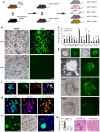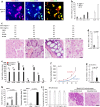Abnormal gametogenesis induced by p53 deficiency promotes tumor progression and drug resistance
- PMID: 30302273
- PMCID: PMC6167385
- DOI: 10.1038/s41421-018-0054-x
Abnormal gametogenesis induced by p53 deficiency promotes tumor progression and drug resistance
Abstract
The century-old embryonal/gametogenesis hypothesis of tumors could link diverse tumors' malignant features together likely representing the real "stemness" of tumors. However, the genetic evidence to validate abnormal gametogenesis in tumors remains lacking. Here we show that p53 deficiency elicits abnormal gametogenesis from primordial germ cell-like stage to late oocyte-like stage and subsequent parthenogenetic activation. The similar upregulation of abnormal gametogenesis by p53 deficiency is observed both in p53-/- mouse model and cultured cancer cells. Notably, germ cell-like cells isolated from distinct tumors from p53-/- mice and cancer cell lines display potent tumorigenicity potential. Abnormal oogenesis induced by p53 deficiency and then spontaneous parthenogenetic activation endow tumors with imitated embryonic development, life cycle, and therapeutic resistance. Our study establishes the genetic evidence to support embryonal/gametogenesis theory of tumors and reveals a pivotal role of p53 in restricting abnormal gametogenesis that may represent a novel aspect for p53's tumor suppression.
Conflict of interest statement
The authors declare that they have no conflict of interest.
Figures






Similar articles
-
Activation of embryonic/germ cell-like axis links poor outcomes of gliomas.Cancer Cell Int. 2022 Nov 26;22(1):371. doi: 10.1186/s12935-022-02792-8. Cancer Cell Int. 2022. PMID: 36435765 Free PMC article.
-
The foundational framework of tumors: Gametogenesis, p53, and cancer.Semin Cancer Biol. 2022 Jun;81:193-205. doi: 10.1016/j.semcancer.2021.04.018. Epub 2021 Apr 30. Semin Cancer Biol. 2022. PMID: 33940178 Free PMC article. Review.
-
Differential expression and dynamic changes of SOX3 during gametogenesis and sex reversal in protogynous hermaphroditic fish.J Exp Zool A Ecol Genet Physiol. 2007 Apr 1;307(4):207-19. doi: 10.1002/jez.361. J Exp Zool A Ecol Genet Physiol. 2007. PMID: 17436330
-
Retinoic acid induces differentiation of buffalo (Bubalus bubalis) embryonic stem cells into germ cells.Gene. 2017 Aug 30;626:358-366. doi: 10.1016/j.gene.2017.05.037. Epub 2017 May 17. Gene. 2017. PMID: 28526652
-
In vitro gametogenesis from embryonic stem cells in livestock species: recent advances, opportunities, and challenges to overcome.J Anim Sci. 2023 Jan 3;101:skad137. doi: 10.1093/jas/skad137. J Anim Sci. 2023. PMID: 37140043 Free PMC article. Review.
Cited by
-
Somatic-to-primordial germ cell-like transformation is critical in tumor initiation of mouse breast tumor 4T1 cells.Am J Cancer Res. 2023 Apr 15;13(4):1471-1485. eCollection 2023. Am J Cancer Res. 2023. PMID: 37168326 Free PMC article.
-
Energy Landscape Reveals the Underlying Mechanism of Cancer-Adipose Conversion in Gene Network Models.Adv Sci (Weinh). 2024 Nov;11(41):e2404854. doi: 10.1002/advs.202404854. Epub 2024 Sep 11. Adv Sci (Weinh). 2024. PMID: 39258786 Free PMC article.
-
The Price of Human Evolution: Cancer-Testis Antigens, the Decline in Male Fertility and the Increase in Cancer.Int J Mol Sci. 2023 Jul 19;24(14):11660. doi: 10.3390/ijms241411660. Int J Mol Sci. 2023. PMID: 37511419 Free PMC article. Review.
-
Activation of embryonic/germ cell-like axis links poor outcomes of gliomas.Cancer Cell Int. 2022 Nov 26;22(1):371. doi: 10.1186/s12935-022-02792-8. Cancer Cell Int. 2022. PMID: 36435765 Free PMC article.
-
The Cancer Aneuploidy Paradox: In the Light of Evolution.Genes (Basel). 2019 Jan 25;10(2):83. doi: 10.3390/genes10020083. Genes (Basel). 2019. PMID: 30691027 Free PMC article.
References
Grants and funding
LinkOut - more resources
Full Text Sources
Research Materials
Miscellaneous

